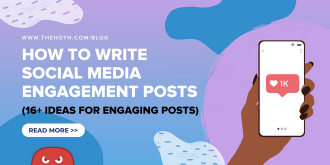Quick Links
Publishing content online has become the #1 way businesses grow their brands, promote their products, and consistently generate new leads.
Before someone else utters the tired cliche ‘content is king’ for the umpteenth time (seriously, it’s time to put that phrase to bed already) – it’s crucial to acknowledge how content marketing will change in the coming years.
In particular, things like voice search and Google’s AI-powered SGE are changing the way users search for content online.
As such, some of the content types that bore fruit in the past have gone out of style.
15-minute-long videos that dive deep into a topic of interest?
Yawn.
That was so 5 years ago.
Short-form videos are all the rage now (think TikTok and YouTube shorts), so you’ll want to produce bite-sized clips that are packed to the gills with information, eye candy, and music.
If you’re still a fan of longer videos, you’ll find more success with live streaming instead of on-demand.
According to research, 80% of users would rather watch a live stream than read a blog post or watch an on-demand video.
Blogs are still very much a thing, but they must be lengthy, extremely informative, and answer commonly asked questions (which will boost your chances of appearing in an SGE AI Snapshot).
In short, people’s tastes in content are changing, so read on to learn the top 5 content types that will matter most in 2024.
Why Do You Need Optimized Content?
Regardless of your business’s industry, your users A) use search engines, B) have social media accounts, and C) have email addresses.
These three online channels also happen to be perfect for promoting your business through content marketing.
What’s that?
Content marketing is where you regularly publish online content to both build an audience and promote your products and services.
It’s one of the most effective forms of inbound marketing, where you draw your audience to you instead of disrupting their experiences (like interrupting a YouTube video they want to see with an ad).
76% of marketers claim that content marketing generates leads, which is why so many companies swear by it.
In fact, 73% of B2B and 70% of B2C companies already implement content marketing, so you don’t want to get left behind.
Here’s a glimpse at a few of the perks a robust content strategy will bring:
- You can achieve thought leadership status, where members of your target audience turn to your brand to learn about the latest developments in your industry.
- As long as you incorporate SEO best practices in your content, you’ll enjoy higher SERP (search engine results pages) rankings – generating more traffic as a result.
- Authoritative content attracts backlinks from other websites that are eager to share your insights – which will help your SEO and reduce the amount of time you have to spend on building links.
- Lots of insightful content that answers common user questions will help you appear in Google’s new SGE Snapshots.
The 5 Most Popular Content Types to Incorporate
Online content is akin to fashion in that certain trends go in and out of style.
That’s why it’s critical for websites to evolve their content strategies in accordance with the trends.
For example, if your products target a younger crowd but you’re still posting blogs on Facebook, it’s the equivalent of showing up to a modern party rocking acid-washed jeans and a mullet.
Trends change, and the younger crowd has moved onto platforms like TikTok and Instagram, and they prefer short-form content like quick video clips and carousels.
Here’s a look at the 5 content types that matter most to today’s audiences.
#1: Informative blog posts that cater to Google SGE
The blogosphere is about to go through some considerable changes – as most websites will shift to writing longer blogs that answer frequently asked questions.
Google’s SGE features an AI Snapshot for some queries, where Google’s generative AI directly answers the user’s query in its own words.
Along with the response, the AI also cites 3 sources online that it drew information from, which is about to become the new organic top 5.
For searches that feature a Snapshot, organic results (and any SERP features) are pushed further down the page into obscurity.
It’s predicted that most users will get the information they need from the Snapshot, which is why getting featured in it is so desirable.
As such, most blogs will cover a topic as thoroughly as possible – while making a point of answering common questions.
Why is that?
Since SGE replies directly to users, most will begin to ask conversational-style questions instead of using ‘industry’ keywords (which has long been the tradition in SEO).
Blogging best practices
So, moving forward, your blogs should contain a minimum of 2,000 words and should target longer, more conversational queries. That will improve your chances of appearing in the SGE Snapshot for your most important keywords, which will be crucial once it’s implemented on a large scale.
Keyword research will still matter in a big way, but it’s also important to do some detective work on your own.
The better you understand your target audience, the easier it’ll be to read their minds when it comes time to create content.
Track down your audience’s online hangouts, and just observe.
Online forums, social media groups, and sites like Quora and Reddit are great places to learn more about a particular audience.
What topics keep coming up? Are they asking a lot of the same questions? Do they have any problems or pain points that your products and services can solve?
Combining this kind of sleuthing with in-depth keyword research is the best way to uncover the topics that matter most to your potential customers.
You should also ensure that all your on-page and technical SEO factors are in order, such as proper keyword usage, optimized metadata, fast loading speeds, and a logical internal linking structure (every page on your site should have at least one internal link pointing to it).
#2: Short-form videos for TikTok, YouTube Shorts, and Instagram
The rise of TikTok brought the prominence of short-form video with it (while taking everyone’s attention spans as a sacrifice, apparently).
Since then, short videos have been the dominant form of content on social media, bar none.
Don’t believe us?
Just take a glance at this graph to see what we mean. Short-form videos are lightyears ahead of other social media content types like long-form videos and even infographics, which is surprising.
If you can’t beat ‘em, join ‘em.
Short-form videos don’t take a lot of resources to make, so there’s not much reason not to join in on the fun.
All you need is a camera (any smartphone works), a 60-second script (roughly 150 words), an actor, and a visually appealing backdrop.
AI-powered content tools will also help you produce videos, as they can help you write scripts, create visuals, and even generate entire videos from scratch.
This type of technology is a game changer for smaller businesses that lack the funds to produce high-quality ads and videos.
Once you start churning out short videos, you can upload them to TikTok, YouTube Shorts, and Instagram. If you don’t have profiles on these platforms already, now is the time to sign up and start networking.
#3: Interactive content like video live streams
As stated in the intro, live streaming has become more popular than on-demand video and blog posts.
Popular streaming services like Twitch and YouTube are no doubt responsible for this shift, as millions of users tune into live streams every single day.
As a form of promotion, live streams are amazing because they provide more engagement than pre-recorded videos.
Your audience members are right there with you via the live chat, and you’ll be able to interact with them on the fly by answering their questions and addressing their comments.
This is a fantastic way to build a loyal following.
If your prospects are able to hang out with you during a live stream while learning a useful skill, they’ll feel a personal connection with you.
That’s especially true if you frequently address the chat, converse, and thank people for their comments.
It makes perfect sense if you think about it.
Which brand would you rather buy from, one where you’re another anonymous customer or one where you personally chatted with the creator?
The choice is obvious, and it proves why forming personal connections with prospects via live streams, virtual events, and webinars is worth it.
#4: Podcasts
The popularity of podcasts is still on the rise, and that trend will likely continue into the coming year.
There are currently 464.7 million podcast listeners online, which is a massive market to capitalize on. Podcasts made a comeback in a big way during the COVID-19 pandemic when everyone was locked inside with not much else to do besides get lost in a stimulating conversation.
Podcasts are also relatively inexpensive to produce, which is a plus.
Not only that, but podcasts are highly versatile and niche-friendly.
There’s a podcast for every topic you can imagine, so it really doesn’t matter if your business caters to very specific interests.
#5: Carousels
Lastly, don’t sleep on the rising popularity and effectiveness of image carousels on platforms like LinkedIn and Instagram.
According to a report by Social Insider, carousels yield the most engagement out of any other content type on Instagram, maintaining an impressive average of 1.92%.
What are carousels?
They’re a series of images and text boxes linked together in a series of slides.
Carousels have become a popular way to deliver complex information, as they’re more interactive and palatable than long blog posts.
Your carousels should contain a balance of images and text, and you should always kick things off with a call to action (remind them to ‘swipe left’).
Implement a Winning Content Strategy for Years to Come
Those are the top 5 types of content you’ll want to start producing for 2024 and beyond.
By writing blogs that cater to SGE, shooting short-form videos, live streaming, recording podcasts, and creating image carousels – your website will continue to thrive despite the changing search landscape.
If you need help mastering SEO and content marketing in 2024, don’t wait to sign up for HOTH X, our managed SEO service.















I love the Hoth, such fantastic information on this blog and great tips which I’m going to use thankyou
Hey Alison,
Right back atcha 😉 Thanks for the comment!
Wow, that was sure an interesting read! Out of which Short-form videos for TikTok, YouTube Shorts, and Instagram is the leading content magnet I must say!